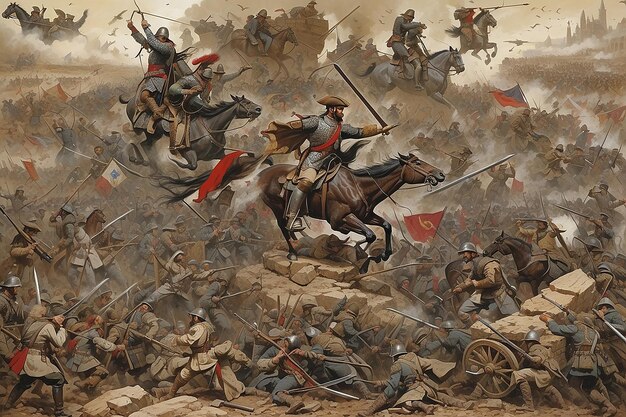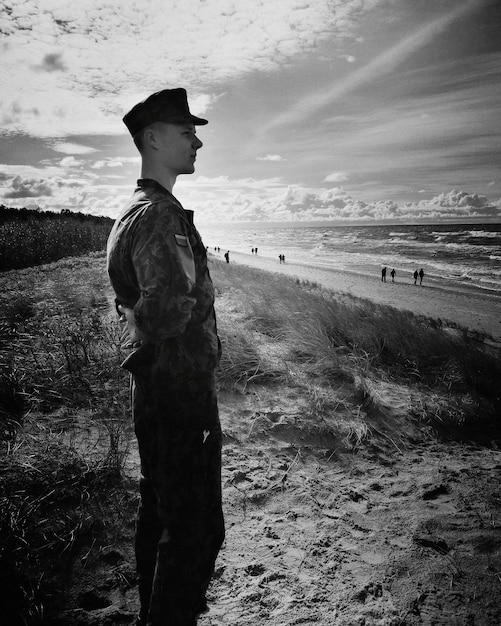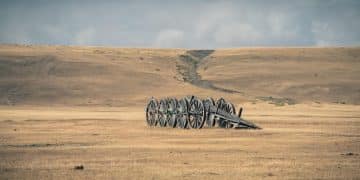The Battle of Gettysburg: Leadership and the Outcome

The Battle of Gettysburg was heavily influenced by leadership decisions made by both Union and Confederate commanders, impacting the outcome of this pivotal Civil War battle.
The Battle of Gettysburg: Examining the Leadership Decisions That Shaped the Outcome remains one of the most pivotal moments in American history, not just for its staggering casualties but also for the crucial leadership decisions that dictated its course. Understanding these decisions offers profound insights into military strategy and the human element of war.
Leadership Roles Before Gettysburg
Before the tumultuous days of Gettysburg, the leaders on both sides had distinct experiences and reputations. These backgrounds critically influenced their approaches to the battle.
Union Leadership
The Union Army of the Potomac had seen a revolving door of commanders. Before Gettysburg, the army was handed to Major General George G. Meade just days before the battle.
- Meade’s Appointment: Meade was appointed to command only three days before the battle, offering him little time to prepare.
- Previous Commanders: A series of unsuccessful commanders preceded Meade, creating instability within the Union ranks.
- Strategic Approach: Despite the chaos, Meade quickly grasped the strategic importance of holding high ground, playing a crucial role in the Union’s defensive strategy.

Meade’s quick adaptation and his focus on defensive tactics were essential in countering the Confederate offensive. His leadership, although recently assumed, provided the Union army with the direction it desperately needed.
Confederate Leadership
In contrast, the Confederate Army of Northern Virginia was spearheaded by General Robert E. Lee, a figure of great respect and tactical acumen.
Lee’s Reputation: Lee enjoyed a stellar reputation for his battlefield successes, instilling confidence in his troops. However, this confidence sometimes led to over-aggression.
- Command Style: Lee’s aggressive style aimed to break the Union’s will to fight through decisive victories on Northern soil.
- Key Commanders: Lee relied substantially on figures like James Longstreet and Richard Ewell.
- Strategic Objectives: Lee’s plan for Gettysburg involved invading the North to compel the Union to sue for peace, but his reliance on aggressive tactics would prove costly.
While Lee’s leadership style had brought victories, it also carried inherent risks. His decisions at Gettysburg would reveal the limitations of an overly aggressive approach against a determined and well-positioned enemy.
Key Decisions on the First Day
The first day of Gettysburg was a maelstrom of unplanned encounters that rapidly escalated. Leadership decisions in these initial hours irrevocably set the stage for the days that followed.
Initial Contact
The battle began almost accidentally when Union cavalry encountered Confederate infantry west of Gettysburg. These initial moments tested the quick-thinking abilities of lower-level commanders.
- Buford’s Defense: Union Brigadier General John Buford recognized the tactical significance of the high ground and ordered his cavalry to delay the Confederate advance, buying crucial time for Union infantry to arrive.
- Heth’s Advance: Confederate General Henry Heth’s decision to engage without fully reconnoitering the area led to a costly and unplanned confrontation.
- Reinforcements: Both sides quickly reinforced their positions, escalating a skirmish into a full-blown battle.

Buford’s strategic foresight in utilizing his cavalry to delay the Confederates and Meade’s insight to quickly reinforce, provided the Union with critical advantages. Their early decisions significantly shaped the battle’s progression, underscoring the crucial role of immediate tactical assessments.
Ewell’s Hesitation
As the Confederates gained ground, General Richard Ewell faced a pivotal decision on Cemetery Hill.
Ewell’s Orders: Lee had given Ewell discretionary orders to take Cemetery Hill “if practicable,” leaving room for interpretation. Ewell hesitated, fearing a strong Union defense.
- Missed Opportunity: Ewell’s hesitation allowed the Union forces to consolidate their position on Cemetery Hill, which became the anchor of their defense.
- Longstreet’s Critique: James Longstreet later criticized Ewell’s inaction as a grave mistake, arguing that taking the high ground early would have significantly altered the battle’s trajectory.
- Defensive Strength: The Union’s firm hold on Cemetery Hill provided them with a commanding position for the remainder of the battle.
Ewell’s hesitation, whether influenced by caution or lack of clear direction, represented a missed opportunity for the Confederates. This moment underscores how crucial immediate decisions can be in seizing tactical advantages.
The Second Day: Tactical Miscalculations
The second day of Gettysburg was marked by intense fighting and tactical miscalculations that cost both sides dearly.
Little Round Top
The struggle for Little Round Top was a defining moment, showcasing the significance of strategic positioning.
- Warren’s Observation: Union General Gouverneur K. Warren noticed the lack of Union troops on Little Round Top and recognized its vital strategic role.
- Chamberlain’s Defense: Colonel Joshua Chamberlain and the 20th Maine regiment staunchly defended Little Round Top, repelling repeated Confederate assaults.
- Strategic Importance: Holding Little Round Top prevented the Confederates from flanking the Union line, preserving the Union’s defensive alignment.
The fierce defense led by Chamberlain and the strategic foresight of Warren solidified the Union’s control of Little Round Top, a key factor in the battle’s outcome. Their leadership ensured the Union army maintained a strong defensive edge, impacting the Confederate’s subsequent strategies.
Longstreet’s Delay
On the Confederate side, James Longstreet’s delayed attack on the Union left flank proved costly.
Longstreet’s Disagreement: Longstreet disagreed with Lee’s plan, advocating for a strategic maneuver around the Union left flank rather than a direct assault, causing hesitations in the attack.
- Lost Momentum: The delay allowed the Union to reinforce their positions, diminishing the impact of the Confederate assault when it finally commenced.
- Hood’s Concerns: General John Bell Hood also voiced concerns about the direct assault, foreseeing heavy casualties.
- Lee’s Insistence: Despite these reservations, Lee insisted on the attack, prioritizing his vision over the advice of his key subordinates.
The discord between Lee and Longstreet, amplified by the delayed assault, weakened the Confederate offensive. This delay provided the Union with the time needed to fortify their defenses.
Pickett’s Charge: A Fatal Decision
The third day culminated in Pickett’s Charge, a disastrous assault that epitomized the risks of aggressive tactics. It exposed critical flaws in the Confederate command strategy and ultimately sealed their defeat.
Preparation and Execution
The attack involved a massive artillery bombardment followed by an infantry assault across open ground towards the Union center on Cemetery Ridge.
- Artillery Barrage: The Confederate bombardment aimed to weaken the Union defenses, but it was largely ineffective due to inaccurate targeting and insufficient ammunition.
- Infantry Advance: Thousands of Confederate soldiers marched across the open field, facing devastating fire from Union artillery and infantry.
- Pickett’s Leadership: General George Pickett led his division courageously, but the attack was doomed from the start due to overwhelming Union resistance.
The execution of Pickett’s Charge revealed severe limitations in Confederate artillery effectiveness, as the Union defenses remained largely intact. The courageous but ultimately futile advance across open ground resulted in catastrophic casualties for the Confederate army.
Consequences of Failure
The failure of Pickett’s Charge had immense consequences for the Confederacy and the overall trajectory of the war.
Heavy Casualties: The assault resulted in thousands of Confederate casualties, decimating key units and severely weakening Lee’s army.
- Strategic Impact: The defeat at Gettysburg marked a turning point in the war, halting Lee’s invasion of the North and diminishing the Confederacy’s chances of achieving independence.
- Lee’s Acknowledgment: Lee took full responsibility for the failed attack, demonstrating his leadership integrity but also underscoring the gravity of the decision.
The aftermath of Pickett’s Charge left the Confederate army crippled and demoralized. The Union victory at Gettysburg solidified their strategic advantage and significantly shifted the momentum of the war in their favor.
Impact of Leadership on the Battle’s Outcome
The Battle of Gettysburg was defined by a series of critical leadership decisions on both sides. These choices not only shaped the immediate course of the battle but also left a lasting impact on the Civil War.
Union Strengths
Union leadership, particularly Meade’s tactical acumen and the defensive strategies employed at key locations, played a crucial role in securing victory.
- Defensive Strategy: Meade’s emphasis on holding high ground and reinforcing strategic positions proved highly effective against Confederate offensives.
- Key Figures: Leaders like Buford, Warren, and Chamberlain demonstrated quick-thinking and bravery, bolstering the Union defense.
The Union’s adept defensive strategy, combined with the decisive actions of its key leaders, solidified its control over vital terrain and stymied Confederate advances.
Confederate Weaknesses
Confederate leadership suffered from strategic miscalculations and a rigid adherence to aggressive tactics, which ultimately led to their defeat.
Lee’s Overconfidence: Lee’s overconfidence and insistence on direct assaults, despite dissenting opinions from his subordinates, resulted in heavy casualties.
- Missed Opportunities: Ewell’s hesitation on the first day and Longstreet’s delayed attack on the second day highlighted the consequences of indecision and disagreement within the Confederate command.
The Confederate’s strategic missteps, compounded by the high cost of aggressive tactics, undermined their offensive capabilities and contributed significantly to their loss.
Conclusion
The Battle of Gettysburg stands as a testament to the critical role leadership plays in determining the outcome of military engagements. The decisions made by commanders such as Meade, Lee, Buford, and Chamberlain significantly shaped the battle’s trajectory, underscoring the importance of strategic foresight, adaptability, and effective communication in the face of adversity. While the courage and sacrifice of individual soldiers on both sides cannot be overstated, it was ultimately the leadership decisions that defined the battle and its lasting impact on American history.
| Key Point | Brief Description |
|---|---|
| ⏱️ Buford’s Defense | Union cavalry delays Confederate advance, securing vital high ground. |
| ⛰️ Ewell’s Hesitation | Confederate General Ewell hesitates to seize Cemetery Hill, a pivotal missed opportunity. |
| 🛡️Little Round Top | Union forces, led by Chamberlain, defend Little Round Top, preventing a Confederate flank. |
| ⚔️ Pickett’s Charge | Confederate assault on Cemetery Ridge fails, resulting in heavy casualties and a turning point in the war. |
Frequently Asked Questions
▼
The main strategic goal for the Confederacy was to invade the North and force the Union to negotiate peace. For the Union, it was to defend against the invasion and protect Washington, D.C.
▼
George Meade strategically positioned the Union army on high ground, enabling a strong defensive stance. He also made quick decisions to reinforce key areas, bolstering Union resistance against Confederate attacks.
▼
Little Round Top was a crucial strategic point that allowed the Union to prevent the Confederates from flanking their main line. Its defense by the 20th Maine was pivotal.
▼
Pickett’s Charge was a direct assault across open ground, making the Confederate soldiers extremely vulnerable. It resulted in massive casualties and failed to break the Union line, weakening the Confederate army.
▼
Robert E. Lee’s aggressive tactics and insistence on a direct assault, despite warnings from his subordinates, led to strategic miscalculations and heavy losses, ultimately contributing to the Confederate defeat.
Conclusion
In conclusion, the Battle of Gettysburg was significantly shaped by the leadership decisions of key figures on both sides. The Union’s defensive strategies and timely reinforcements, combined with Confederate miscalculations and costly assaults, determined the outcome of this pivotal battle. The leadership lessons from Gettysburg continue to resonate in military strategy and historical analysis.





